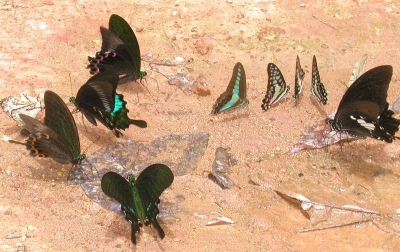
Mud-puddling, or simply puddling, is a behaviour most conspicuous in butterflies, but occurs in other animals as well, mainly insects; they seek out nutrients in certain moist substances such as rotting plant matter, mud and carrion and they suck up the fluid. Where the conditions are suitable, conspicuous insects such as butterflies commonly form aggregations on wet soil, dung or carrion. From the fluids they obtain salts and amino acids that play various roles in their physiology, ethology and ecology.
Males seem to benefit from the sodium uptake through mud-puddling behaviour with an increase in reproductive success. The collected sodium and amino acids are often transferred to the female with the spermatophore during mating as a nuptial gift. This nutrition also enhances the survival rate of the eggs.
When puddling, many butterflies and moths pump fluid through the digestive tract and release fluid from their anus. In some, such as the male notodontid Gluphisia crenata, this is released in forced anal jets at 3 second intervals. Fluid of up to 600 times the body mass may pass through and males have a much longer ileum (anterior hindgut) than non-puddling females.
Picture Credit : Google



